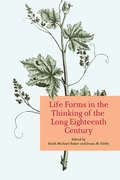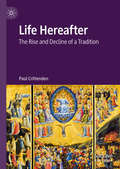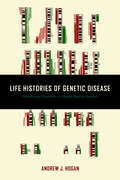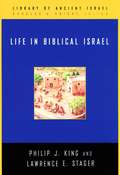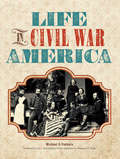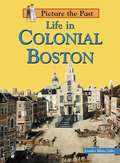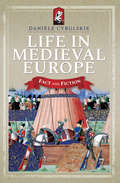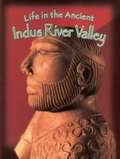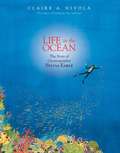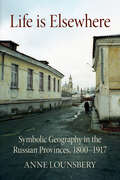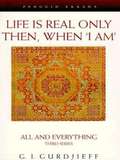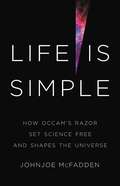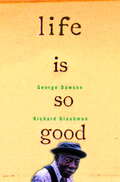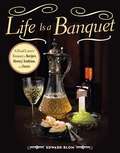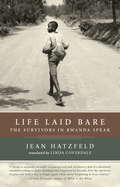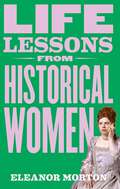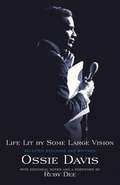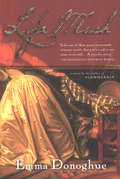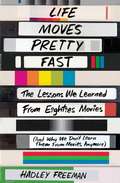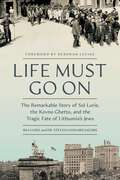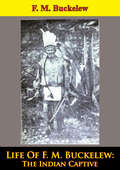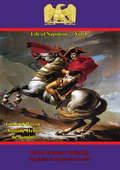- Table View
- List View
Life Forms in the Thinking of the Long Eighteenth Century
by Keith Baker Jenna GibbsFor many years, scholars have been moving away from the idea of a singular, secular, rationalistic, and mechanistic "Enlightenment project." Historian Peter Reill has been one of those at the forefront of this development, demonstrating the need for a broader and more varied understanding of eighteenth-century conceptions of nature. RediscoveringLife Forms in the Thinking of the Long Eighteenth Century is a unique reappraisal of Enlightenment thought on nature, biology, and the organic world that responds to Reill's work. The ten essays included in the collection analyse the place of historicism, vitalism, and esotericism in the eighteenth century - three strands of thought rarely connected, but all of which are central to Reill's innovative work. Working across national and regional boundaries, they engage not only French and English but also Italian, Swiss, and German writers.
Life Hereafter: The Rise and Decline of a Tradition
by Paul CrittendenIn this book, Paul Crittenden offers a critical guide to the problematic origins of biblical teaching about the afterlife and the way in which it was subsequently developed by Church authorities and theologians—Origen, Augustine, and Thomas Aquinas in particular. In the post–Reformation era the focus falls on the challenges set by modern secularism. The tradition encompasses a body of interconnected themes: an apocalyptic war in which the Kingdom of God triumphs over Satan’s powers of darkness; salvation in Christ; the immortality of the soul; and finally the resurrection of the dead and the last judgment, ratifying an afterlife of eternal bliss for the morally good and punishment in hell for wrongdoers. The critique questions these beliefs on evidential, ethical, and philosophical grounds. The argument overall is that what lies beyond death is beyond knowledge. The one fundamental truth that can be distilled from the once compelling body of Christian eschatological belief—for believers and unbelievers alike—is the importance of living ethically.
Life Histories of Genetic Disease: Patterns and Prevention in Postwar Medical Genetics
by Andrew J. HoganA history of genetic testing warns that such tests may tell us more than we want to know.Medical geneticists began mapping the chromosomal infrastructure piece by piece in the 1970s by focusing on what was known about individual genetic disorders. Five decades later, their infrastructure had become an edifice for prevention, allowing today’s expecting parents to choose to test prenatally for hundreds of disease-specific mutations using powerful genetic testing platforms. In Life Histories of Genetic Disease, Andrew J. Hogan explores how various diseases were "made genetic" after 1960, with the long-term aim of treating and curing them using gene therapy. In the process, he explains, these disorders were located in the human genome and became targets for prenatal prevention, while the ongoing promise of gene therapy remained on the distant horizon.In narrating the history of research that contributed to diagnostic genetic medicine, Hogan describes the expanding scope of prenatal diagnosis and prevention. He draws on case studies of Prader-Willi, fragile X, DiGeorge, and velo-cardio-facial syndromes to illustrate that almost all testing in medical genetics is inseparable from the larger—and increasingly "big data"–oriented—aims of biomedical research. Hogan also reveals how contemporary genetic testing infrastructure reflects an intense collaboration among cytogeneticists, molecular biologists, and doctors specializing in human malformation.Hogan critiques the modern ideology of genetic prevention, which suggests that all pregnancies are at risk for genetic disease and should be subject to extensive genomic screening. He examines the dilemmas and ethics of the use of prenatal diagnostic information in an era when medical geneticists and biotechnology companies have begun offering whole genome prenatal screening—essentially searching for any disease-causing mutation. Hogan’s focus and analysis is animated by ongoing scientific and scholarly debates about the extent to which the preventive focus in contemporary medical genetics resembles the aims of earlier eugenicists. Written for historians, sociologists, and anthropologists of science and medicine, as well as bioethics scholars, physicians, geneticists, and families affected by genetic conditions, Life Histories of Genetic Disease is a profound exploration of the scientific culture surrounding malformation and mutation.
Life Histories of Genetic Disease: Patterns and Prevention in Postwar Medical Genetics
by Andrew J. HoganA richly detailed history that “uncovers the challenges and limitations of our increasing reliance on genetic data in medical decision making” (Shobita Parthasarathy, author of Building Genetic Medicine).Medical geneticists began mapping the chromosomal infrastructure piece by piece in the 1970s by focusing on what was known about individual genetic disorders. Five decades later, their infrastructure had become an edifice for prevention, allowing expectant parents to test prenatally for hundreds of disease-specific mutations using powerful genetic testing platforms. In this book, Andrew J. Hogan explores how various diseases were “made genetic” after 1960, with the long-term aim of treating and curing them using gene therapy. In the process, he explains, these disorders were located in the human genome and became targets for prenatal prevention, while the ongoing promise of gene therapy remained on the distant horizon.In narrating the history of research that contributed to diagnostic genetic medicine, Hogan describes the expanding scope of prenatal diagnosis and prevention. He draws on case studies of Prader-Willi, fragile X, DiGeorge, and velo-cardio-facial syndromes to illustrate that almost all testing in medical genetics is inseparable from the larger—and increasingly “big data”–oriented—aims of biomedical research. Hogan also reveals how contemporary genetic testing infrastructure reflects an intense collaboration among cytogeneticists, molecular biologists, and doctors specializing in human malformation.Hogan critiques the modern ideology of genetic prevention, which suggests all pregnancies are at risk for genetic disease and should be subject to extensive genomic screening. He examines the dilemmas and ethics of the use of prenatal diagnostic information in an era when medical geneticists and biotechnology companies offer whole genome prenatal screening—essentially searching for any disease-causing mutation. Hogan’s analysis is animated by ongoing scientific and scholarly debates about the extent to which the preventive focus in contemporary medical genetics resembles the aims of earlier eugenicists. Written for historians, sociologists, and anthropologists of science and medicine, as well as bioethics scholars, physicians, geneticists, and families affected by genetic conditions, Life Histories of Genetic Disease is a profound exploration of the scientific culture surrounding malformation and mutation.
Life In Biblical Israel
by Philip King Lawrence StagerThis special-edition volume of the Library of Ancient Israel, based on the latest research, presents a vivid description of the world of Ancient Israel, covering such topics as domestic life, the means of existence, cultural expression, and religious practices. With over 175 full-color pictures and illustrations,Life in Biblical Israelopens the door to everyday life in biblical Israel for all readers. This volume is perfect for classrooms, coffee tables, and personal use. <p><p> Volumes in the Library of Ancient Israel draw on multiple disciplines--such as archaeology, anthropology, sociology, linguistics, and literary criticism--to illuminate the everyday realities and social subtleties these ancient cultures experienced. This series employs sophisticated methods resulting in original contributions that depict the reality of the people behind the Hebrew Bible and interprets these insights for a wide variety of readers.
Life In Civil War America: A Guide To Everyday Life During The War Between The States
by Michael J. VarholaAuthor and historian Michael J. Varhola takes you back in time to the Civil War, illuminating both the sweeping changes and cultural norms that shaped the everyday lives of soldiers and civilians during the war that divided the nation.
Life In Colonial Boston (Picture The Past Ser.)
by Jennifer Blizin GillisThis book tells about life in Boston, Massachusetts, from 1760 to 1773. Boston was one of the largest cities in the thirteen colonies of Great Britain. At first, the people who live in Boston copied the way things were done in Britain. But as time passed, they grew unhappy with the fact that they did not make their own laws. By the 1760s, Bostonians felt they were paying too many taxes to Britain. They felt they had no say in how their colony was being run. People began to hold meetings to complain about the taxes and to talk about independence. The Bostonians wanted to be free from Great Britain. We have illustrated the book with paintings and drawings from colonial times and with artists ideas of how things looked then."
Life In Medieval Europe: Fact and Fiction
by Danièle Cybulskie&“A lovely, witty treasure trove of a book, spilling over with historical gems . . . a very human history: sometimes weird, always wonderful.&” —Dan Jones, New York Times-bestselling author Have you ever found yourself watching a show or reading a novel and wondering what life was really like in the Middle Ages? What did people actually eat? Were they really filthy? And did they ever get to marry for love? In Life in Medieval Europe: Fact and Fiction, you&’ll find fast and fun answers to all your secret questions, from eating and drinking to sex and love. Find out whether people bathed, what they did when they got sick, and what actually happened to people accused of crimes. Learn about medieval table manners, tournaments, and toothpaste, and find out if people really did poop in the moat. &“To say that this book was fun to read would be an understatement. Cybulskie&’s knowledge radiates in every page of this short book . . . It was educational and entertaining all at the same time. Simply a wonderful resource for novice medievalists and writers of historical fiction and nonfiction alike.&” —Adventures of a Tudor Nerd &“All in all, this is an excellent book to put to bed many of the myths surrounding medieval existence that persist in the popular imagination. Easy to read and well worth the time to read it. I highly recommend this book if you want to get a mostly unbiased view of medieval life.&” —Battles and Book Reviews
Life In The Ancient Indus River Valley (Peoples of the Ancient World)
by Hazel Richardson5000 years ago, people built the Harappa city in the Indus valley with clay clad walls, sewage system and trade records! The book is a timeline from the Harappan civilization to Aryans to Mauryas and Guptas.
Life In The Ocean: The Story Of Oceanographer Sylvia Earle
by Claire A. NivolaSylvia Earle first lost her heart to the ocean as a young girl when she discovered the wonders of the Gulf of Mexico in her backyard. As an adult, she dives even deeper. Whether she's designing submersibles, swimming with the whales, or taking deep-water walks, Sylvia Earle has dedicated her life to learning more about what she calls "the blue heart of the planet." With stunningly detailed pictures of the wonders of the sea, Life in the Ocean tells the story of Sylvia's growing passion and how her ocean exploration and advocacy have made her known around the world. This picture book biography also includes an informative author's note that will motivate young environmentalists.
Life Is Elsewhere: Symbolic Geography in the Russian Provinces, 1800–1917 (NIU Series in Slavic, East European, and Eurasian Studies)
by Anne LounsberyIn Life Is Elsewhere, Anne Lounsbery shows how nineteenth-century Russian literature created an imaginary place called "the provinces"—a place at once homogeneous, static, anonymous, and symbolically opposed to Petersburg and Moscow. Lounsbery looks at a wide range of texts, both canonical and lesser-known, in order to explain why the trope has exercised such enduring power, and what role it plays in the larger symbolic geography that structures Russian literature's representation of the nation's space. Using a comparative approach, she brings to light fundamental questions that have long gone unasked: how to understand, for instance, the weakness of literary regionalism in a country as large as Russia? Why the insistence, from Herzen through Chekhov and beyond, that all Russian towns look the same? In a literary tradition that constantly compared itself to a western European standard, Lounsbery argues, the problem of provinciality always implied difficult questions about the symbolic geography of the nation as a whole. This constant awareness of a far-off European model helps explain why the provinces, in all their supposed drabness and predictability, are a topic of such fascination for Russian writers—why these anonymous places are in effect so important and meaningful, notwithstanding the culture's nearly unremitting emphasis on their nullity and meaninglessness.
Life Is Real Only Then, When I Am: All and Everything Third Series
by G. I. GurdjieffBegun in 1934, this final volume of Gurdjieff's trilogy, All and Everything, is a primary source for Gurdjieff's ideas, methods, and biography. Gurdjieff offers guidance to his "community of seekers," through a selection of talks given in 1930, autobiographical material crucial to understanding his ideas, and the incomplete essay "The Outer and Inner World of Man. " Available for the first time in paperback, this is the ultimate piece of Gurdjieff's work that his numerous followers have been waiting for. .
Life Is Simple: How Occam's Razor Set Science Free and Shapes the Universe
by Johnjoe McFadden"In short, Life Is Simple is enthralling."--Michael Blastland, ProspectA biologist argues that simplicity is the guiding principle of the universe Centuries ago, the principle of Ockham&’s razor changed our world by showing simpler answers to be preferable and more often true. In Life Is Simple, scientist Johnjoe McFadden traces centuries of discoveries, taking us from a geocentric cosmos to quantum mechanics and DNA, arguing that simplicity has revealed profound answers to the greatest mysteries. This is no coincidence. From the laws that keep a ball in motion to those that govern evolution, simplicity, he claims, has shaped the universe itself. And in McFadden&’s view, life could only have emerged by embracing maximal simplicity, making the fundamental law of the universe a cosmic form of natural selection that favors survival of the simplest. Recasting both the history of science and our universe&’s origins, McFadden transforms our understanding of ourselves and our world.
Life Is So Good
by Richard Glaubman George DawsonA heartwarming memoir of a man who knew that something was missing in his life. That something was reading. At 98 years old, he learned, and at 101 he worked on this book.
Life Is a Banquet: A Food Lover?s Treasury of Recipes, History, Tradition, and Feasts
by Edward BlomSwedish television personality and food historian Edward Blom is a cook with a big personality and a big passion. This to his culinary kingdom! Blom's expertise lies in the cultural history of food, and in Life Is a Banquet he throws open the archives and invites all to indulgence in the excesses of yesteryear's best recipes. These are Blom's favorites, each enlivened with his own personal slant.Here is everything from the Bavarian Oktoberfest to the oysters of Grand Central Station, the tables of the nineteenth century elite to the precursor of the Smörgåsborg: the brännvinsbord. All made with the motto: elegant and in excess.Featuring 90 recipes, dazzling photographs, personal anecdotes, and highlights of culinary history, Life Is a Banquet is a cookbook like no other. Be amazed, be inspired, and be tempted to make food history!
Life Laid Bare
by Linda Coverdale Jean Hatzfeld"To make the effort to understand what happened in Rwanda is a painful task that we have no right to shirk-it is part of being a moral adult."-Susan SontagIn the late 1990s, French author and journalist Jean Hatzfeld made several journeys into the hilly, marshy region of the Bugesera, one of the areas most devastated by the Rwandan genocide of April 1994, where an average of five out of six Tutsis were hacked to death with machete and spear by their Hutu neighbors and militiamen. In the villages of Nyamata and N'tarama, Hatzfeld interviewed fourteen survivors of the genocide, from orphan teenage farmers to the local social worker. For years the survivors had lived in a muteness as enigmatic as the silence of those who survived the Nazi concentration camps. In Life Laid Bare, they speak for those who are no longer alive to speak for themselves; they tell of the deaths of family and friends in the churches and marshes to which they fled, and they attempt to account for the reasons behind the Tutsi extermination. For many of the survivors "life has broken down," while for others, it has "stopped," and still others say that it "absolutely must go on."These horrific accounts of life at the very edge contrast with Hatzfeld's own sensitive and vivid descriptions of Rwanda's villages and countryside in peacetime. These voices of courage and resilience exemplify the indomitable human spirit, and they remind us of our own moral responsibility to bear witness to these atrocities and to never forget what can come to pass again. Winner of the Prix France Culture and the Prix Pierre Mille, Life Laid Bare allows us, in the author's own words, "to draw as close as we can get to the Rwandan genocide."
Life Lessons From Historical Women
by Eleanor MortonTake a tour of the past and uncover stories of the women whose lives and achievements have shaped our modern world. In Life Lessons from Historical Women, Eleanor Morton celebrates the ordinary women whose decisions and accomplishments in their everyday lives resonate with us today.Taking inspiration from the thriving self-help genre, Morton reasons that the greatest lessons can be taken from the female forebears who have come before - women whose actions inspire purpose, creativity and rebellion... without a side of pseudo psychology and judgement...Covering the full gamut of the female experience, and women from all corners of history and the globe, Life Lessons from Historical Women includes chapters on 'How To Thrive' with Judith Kerr, 'Think Like an Entrepreneur' with Mary Seacole, and 'How Not to Give a Fuck' with the famous suffragette martyr Emily Davison.Whether it's what we can learn from the first woman to summit Everest or the trailblazing ladies who confirm that pockets have always been must-have in women's clothing, Eleanor writes with humour and a sincere respect for our history, and imparts valuable lessons for the modern female.
Life Lessons From Historical Women
by Eleanor MortonTake a tour of the past and uncover stories of the women whose lives and achievements have shaped our modern world. In Life Lessons from Historical Women, Eleanor Morton celebrates the ordinary women whose decisions and accomplishments in their everyday lives resonate with us today.Taking inspiration from the thriving self-help genre, Morton reasons that the greatest lessons can be taken from the female forebears who have come before - women whose actions inspire purpose, creativity and rebellion... without a side of pseudo psychology and judgement...Covering the full gamut of the female experience, and women from all corners of history and the globe, Life Lessons from Historical Women includes chapters on 'How To Thrive' with Judith Kerr, 'Think Like an Entrepreneur' with Mary Seacole, and 'How Not to Give a Fuck' with the famous suffragette martyr Emily Davison.Whether it's what we can learn from the first woman to summit Everest or the trailblazing ladies who confirm that pockets have always been must-have in women's clothing, Eleanor writes with humour and a sincere respect for our history, and imparts valuable lessons for the modern female.
Life Lessons From Historical Women
by Eleanor MortonTake a tour of the past and uncover stories of the women whose lives and achievements have shaped our modern world. In Life Lessons from Historical Women, Eleanor Morton celebrates the ordinary women whose decisions and accomplishments in their everyday lives resonate with us today.Taking inspiration from the thriving self-help genre, Morton reasons that the greatest lessons can be taken from the female forebears who have come before - women whose actions inspire purpose, creativity and rebellion... without a side of pseudo psychology and judgement...Covering the full gamut of the female experience, and women from all corners of history and the globe, Life Lessons from Historical Women includes chapters on 'How To Thrive' with Judith Kerr, 'Think Like an Entrepreneur' with Mary Seacole, and 'How Not to Give a Fuck' with the famous suffragette martyr Emily Davison.Whether it's what we can learn from the first woman to summit Everest or the trailblazing ladies who confirm that pockets have always been must-have in women's clothing, Eleanor writes with humour and a sincere respect for our history, and imparts valuable lessons for the modern female.
Life Lit by Some Large Vision
by Ruby Dee Ossie DavisOssie Davis, the celebrated civil rights activist, actor, writer, and director, is remembered for a film, television, and stage career of more than half a century. His awards include an Emmy Award, an NAACP Image Award for his work in the Spike Lee film Do the Right Thing, a Lifetime Achievement Award from the Screen Actors Guild, and a Kennedy Center Honor. The last two honors, like so many of his accomplishments, were shared with his wife and partner (in life and in work), Ruby Dee. Ossie Davis is also revered for his lifelong commitment to those social and political causes about which he was so passionate. Of all the gifts he possessed, perhaps none was greater than his ability to articulate the important issues of the day. He used his brilliant mind and his oratory skills to give voice to his concerns as a black man, an American, and a human being in the world, as well as to the individuals and communities whose concerns he made his own. This monumental book brings together many of the moving speeches, essays, and other writings as an ultimate gift to posterity. Life Lit by Some Large Vision includes some humor, some history, and some surprises: moving tributes to such luminaries as Malcolm X and Louis Armstrong; thought-provoking speeches on the treachery of the English language and the challenge of breaking through the "niggerization" process; letters to friends and fellow thinkers; essays that span decades of social thought and revolutionary positions; and the closing monologue from his groundbreaking 1961 play, Purlie Victorious. The unforgettable sound of Ossie Davis's voice is well documented in his work on film and television, but the words on these pages offer his heart and mind, and will be the next best thing to witnessing him speak in person. Ruby Dee contributes a foreword to the collection and introductory notes to the individual pieces, many of which were written and delivered with her at his side. The result is a comprehensive celebration of one man's extraordinary wisdom and generosity. This is a book that will enrich countless readers -- as a gift, an educational resource, a volume to be read aloud on special occasions, and much more.
Life Mask: A Novel
by Emma DonoghuePrivilege has a price for three high-society Londoners in this eighteenth-century historical novel by the author of Room and The Pull of the Stars. In a time of looming war, of glittering spectacle and financial disasters, the wealthy liberals of the Whig Party work to topple a tyrannical prime minister and a lunatic king. Marriages and friendships stretch or break; political liaisons prove as dangerous as erotic ones; and everyone wears a mask. Will Eliza Farren, England's leading comedic actress, gain entry to that elite circle that calls itself the World? Can Lord Derby, the inventor of the horse race that bears his name, endure public mockery of his long, unconsummated courtship of the actress? Will Anne Damer, a sculptor and rumored Sapphist, be the cause of Eliza's fall from grace? Let the games begin . . .&“Mesmerizing. With the French Revolution raging in the background, Donoghue has lighted on another terrific story, and she pulls off a dazzling feat of choreography.&” —Julia Livshin, The Washington Post Book World&“Few will be able to put it down before its enthralling tales end.&” —Chicago Tribune
Life Moves Pretty Fast: The Lessons We Learned from Eighties Movies (and Why We Don't Learn Them from Movies Anymore)
by Hadley FreemanFrom Vogue contributor and Guardian columnist Hadley Freeman, a personalized guide to eighties movies that describes why they changed movie-making forever—featuring exclusive interviews with the producers, directors, writers and stars of the best cult classics.For Hadley Freeman, movies of the 1980s have simply got it all. Comedy in Three Men and a Baby, Hannah and Her Sisters, Ghostbusters, and Back to the Future; all a teenager needs to know in Pretty in Pink, Ferris Bueller’s Day Off, Say Anything, The Breakfast Club, and Mystic Pizza; the ultimate in action from Top Gun, Die Hard, Beverly Hills Cop, and Indiana Jones and the Temple of Doom; love and sex in 9 1/2 Weeks, Splash, About Last Night, The Big Chill, and Bull Durham; and family fun in The Little Mermaid, ET, Big, Parenthood, and Lean On Me. In Life Moves Pretty Fast, Hadley puts her obsessive movie geekery to good use, detailing the decade’s key players, genres, and tropes. She looks back on a cinematic world in which bankers are invariably evil, where children are always wiser than adults, where science is embraced with an intense enthusiasm, and the future viewed with giddy excitement. And, she considers how the changes between movies then and movies today say so much about society’s changing expectations of women, young people, and art—and explains why Pretty in Pink should be put on school syllabuses immediately. From how John Hughes discovered Molly Ringwald, to how the friendship between Dan Aykroyd and John Belushi influenced the evolution of comedy, and how Eddie Murphy made America believe that race can be transcended, this is a “highly personal, witty love letter to eighties movies, but also an intellectually vigorous, well-researched take on the changing times of the film industry” (The Guardian).
Life Must Go On: The Remarkable Story of Sol Lurie, the Kovno Ghetto, and the Tragic Fate of Lithuania's Jews
by Bea LurieThe remarkable story of Sol Lurie, a child survivor of six concentration camps during the Holocaust, who continues to be a beacon of hope.After a bucolic childhood in Kovno, Lithuania, Sol was just eleven when the Nazis invaded and he and his family were forced to move into the Kovno Ghetto. The Kovno Ghetto was one of the only ghettos to later become a concentration camp, and Sol was among just a few Jewish survivors from Kovno. In this inspiring story of tenacity, character, faith, love, and forgiveness, we follow young Sol through heartbreak and fear, torment and torture. Through Sol's eyes, we learn the history of the communities in Eastern Europe, especially Lithuania, which has long been a gap in the wider history of the Holocaust. Along the way, we meet the righteous few who helped save young Sol's life. After being imprisoned in five other concentration camps for a total of four years, Sol was liberated from Buchenwald on his fifteenth birthday. To this day, he still joyfully celebrates every year the day he was born and liberated. Despite the horrors of youth, Sol never lost his determination to live life to the fullest. He embarked on a new life in the United States and would thrive as a husband, father, grandfather, business owner, and an inspiration for the thousands who have heard Sol share his incredible story—and the lessons he has to share. We can all learn from Sol at a time when divisiveness reigns. Despite all that he suffered and all those he lost, Sol&’s courage and positive attitude continues to inspire as he actively seeks out and see the good in others. He wholeheartedly believes in bashert, a Yiddish word that means &“destiny,&” which gave him his &“mission to educate others to love, not to hate.&” Life Must Go On is a moving and vital new addition to the history of the Holocaust and the chorus of survivor stories that resonate throughout the generations.
Life Of F. M. Buckelew: The Indian Captive
by F. M. Buckelew Thomas S. DennisThe Reverend F. M. Buckelew started his life as one of a family of nine, born in 1852 in Union Parish, Louisiana. His father saw the opportunities out West and made travelled out into the wilds of Texas with his family to Cherokee County, Texas. As the author recounts, life there was hard, and before long his mother was dead along with one of his sisters; worse was to follow as he was captured by Lipan Indians at the age of fourteen. In his extraordinary tale he tells of his captivity among the Native Americans, recording their customs, way of life and eventual escape from their clutches.
Life Of Napoleon — Vol. I. (Life Of Napoleon #1)
by General Baron Antoine Henri de Jomini General H. W. HalleckThe life of Napoleon is etched still across the history of Europe, in the wars he waged, the dynasties that he toppled, and the laws he enacted. Even in an epoch rich in social change, from the bottom up he remains a fascinating figure; biographers face the challenge of doing justice to such a multi-faceted character. Few can have been said to have access to the Emperor as much as the generals that served under him throughout his many campaigns; General Jomini spent many year serving the Emperor and many more in the company of some of his enemies putting him in an excellent position to write his biography. Written as if by Napoleon himself, Jomini traces Napoleon's political and military successes and failures, weaving them into a seamless narrative that makes his work one of the few rounded biographies of Napoleon.This first volume covers Napoleon's early years from birth in Ajaccio in Corsica to his ascent to the Consulship and the peace of Amiens in 1802.Of the Author -- General Jomini saw much service during the Napoleonic Wars, initially working in staff positions for Marshal Ney prior to being attached to the Emperor's own headquarters during the 1806 and 1807 campaigns. He was pushed out of the Grande Armée into the arms of the Russian service in 1813, becoming aide-de-camp to the Tzar. He was famous for his copious output of works on the military theory and strategy employed during the French Revolution, the Napoleonic Wars, and even those of Frederick the Great. He is often remembered for his chef d'œuvre, the "Art of War", and has been dubbed the "founder of modern strategy" by historian John Shy.Author -- General Baron Antoine Henri de Jomini (1779-1869)Translator -- General H. W. Halleck (1815-1872
